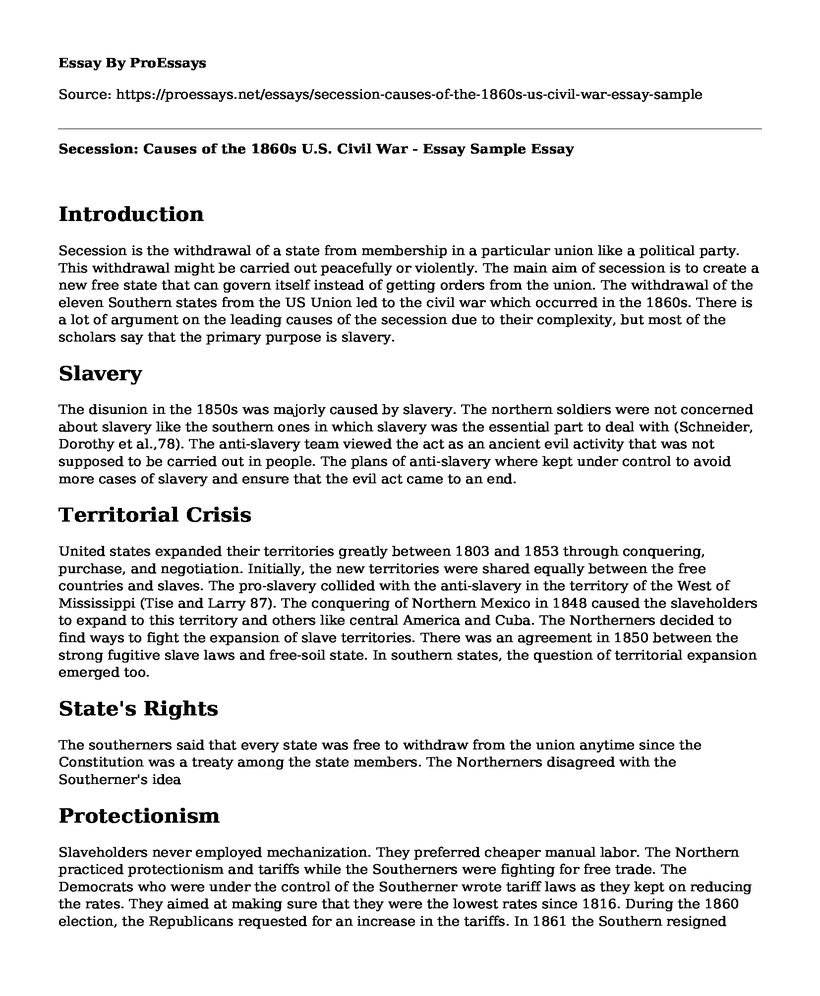Introduction
Secession is the withdrawal of a state from membership in a particular union like a political party. This withdrawal might be carried out peacefully or violently. The main aim of secession is to create a new free state that can govern itself instead of getting orders from the union. The withdrawal of the eleven Southern states from the US Union led to the civil war which occurred in the 1860s. There is a lot of argument on the leading causes of the secession due to their complexity, but most of the scholars say that the primary purpose is slavery.
Slavery
The disunion in the 1850s was majorly caused by slavery. The northern soldiers were not concerned about slavery like the southern ones in which slavery was the essential part to deal with (Schneider, Dorothy et al.,78). The anti-slavery team viewed the act as an ancient evil activity that was not supposed to be carried out in people. The plans of anti-slavery where kept under control to avoid more cases of slavery and ensure that the evil act came to an end.
Territorial Crisis
United states expanded their territories greatly between 1803 and 1853 through conquering, purchase, and negotiation. Initially, the new territories were shared equally between the free countries and slaves. The pro-slavery collided with the anti-slavery in the territory of the West of Mississippi (Tise and Larry 87). The conquering of Northern Mexico in 1848 caused the slaveholders to expand to this territory and others like central America and Cuba. The Northerners decided to find ways to fight the expansion of slave territories. There was an agreement in 1850 between the strong fugitive slave laws and free-soil state. In southern states, the question of territorial expansion emerged too.
State's Rights
The southerners said that every state was free to withdraw from the union anytime since the Constitution was a treaty among the state members. The Northerners disagreed with the Southerner's idea
Protectionism
Slaveholders never employed mechanization. They preferred cheaper manual labor. The Northern practiced protectionism and tariffs while the Southerners were fighting for free trade. The Democrats who were under the control of the Southerner wrote tariff laws as they kept on reducing the rates. They aimed at making sure that they were the lowest rates since 1816. During the 1860 election, the Republicans requested for an increase in the tariffs. In 1861 the Southern resigned from their seats, and that is when the taxes were only enacted.
Sectionalism
The sectionalism was caused by various economic, social structures, political values, and customs of the South and North. In 1812, the rise of tension caused the Hartford convention. The convention showed how the northerners were dissatisfied with foreign trade. The trade was said to affect the industrial North excessively, new states weakening the power of the Northern, the Three-Fifth Negotiation, and a succession of Southern Presidents. Between 1800 and 1860 the sectionalism increased regularly and evenly. This sectionalism gradually reduced slavery, led to urbanization, industrialized, and constructed affluent farms as the Southerners concentrated on plantation agriculture in which they employed slave labor and subsistence farming practiced by poor free men. Between 1840 and 1850, the acceptance of slavery divided the most significant denomination into Northern and Southern faith. Here has been a debate on whether the difference in economy between the Southern and Northern states caused the war.
Nationalism
In the 19th century, nationalism was a significant force. It was carried out by spokesmen like Daniel Webster and Andrew Jackson. The Northerners were all supporters of the union. At the same time, the Southerners were split into two, those who were loyal to the association and those whose loyalty was to the Southern region and the Confederacy. The south was forming a Southern Nationalism. The Northerners did not support any method that would lead to the division of the union though they were also concerned about nationalism. In 1860 the Republicans warned that they view disunion as treason, and it has consequences.
Lincoln's Election
Finally, the election of Abraham Lincoln, which occurred in November 1860, triggered the secession. Treaties like "Crittenden Compromise" and Corwin "Amendment failed" failed. The Southerners feared that Lincoln would lead to the end of slavery expansion (Guelzo and Allen 70). The slave states were becoming minor in the House of Representatives since the state of being a minority seemed to be never-ending. In March 1961, seven slave states had withdrawn from the state of the union and formed a confederacy.
Conclusion
In conclusion, the secession took place after Lincoln was elected when the southerners decided to withdrawal from the party due to the fear of loss of representatives in the House since they would not be able to promote pro-slavery acts and policies.
Works Cited
Guelzo, Allen C. Lincoln's Emancipation Proclamation: The End of Slavery in America. Simon and Schuster, 2005.
Schneider, Dorothy, and Carl J. Schneider. Slavery in America. Infobase Publishing, 2014.
Tise, Larry E. Proslavery: A history of the defense of slavery in America, 1701-1840. University of Georgia Press, 1990.
Cite this page
Secession: Causes of the 1860s U.S. Civil War - Essay Sample. (2023, May 23). Retrieved from https://proessays.net/essays/secession-causes-of-the-1860s-us-civil-war-essay-sample
If you are the original author of this essay and no longer wish to have it published on the ProEssays website, please click below to request its removal:
- Essay on Reconstruction Through World War II
- Fracking and the Impacts Essay Example
- Essay Sample on Structural Realism After the Cold War
- Essay Example on Immigration in the US: From Reconstruction to Modern Times
- Essay on Comparing Microeconomic Effects of the Great Depression and Current Economic Crisis
- Essay on Andreesen Horowitz: Investing in the Future of Technology & Innovation
- The Neolithic Era and Revolution - Free Paper Example







